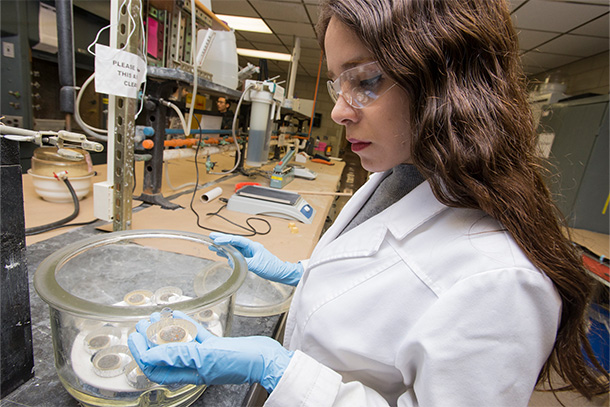Decarbonization of the Built Environment

The decarbonization of the built environment thematic area focuses on reducing or eliminating carbon dioxide emissions associated with the construction and operation of civil infrastructure. Researchers in this area advance innovative technologies in support of carbon-neutral materials, energy efficient buildings, and sustainable construction and land development practices.
Example research topics include:
- Developing carbon-neutral and high-performance materials
Example projects: Carbon-negative ready-mix concrete building components through direct air capture; Decarbonizing concrete by using biochar as lightweight aggregate and mineral filler; Utilizing alternative supplementary cementitious materials in highway applications; Advancing hempcrete as a load-bearing highly insulated carbon-negative construction material; Innovative cement- and water-free concrete using waste plastic binder - Automating construction and 3D printing
Example projects: Using expanded polystyrene in 3D concrete Printing for enhanced thermal insulation and lower weight; Introduction of barbed wire as an innovative reinforcement for 3D concrete printing; Design and implementation of novel 3D binders to address the housing crisis in Alaska - Improving the design of energy-efficient buildings
Example projects: Improving whole house energy efficiency in homes with hempcrete walls; Retrofit approaches and prioritization to upgrade existing homes to a highly energy efficient passive house standard - Advancing low-impact residential construction
Example projects: Use of cob, hempcrete, and bamboo for sustainable home building; Next generation insulated concrete form home building with recycled or waste materials - Evaluating nature-based solutions/ green infrastructure
Example projects: Field assessment of green stormwater infrastructure to understand how they may sequester carbon in soils and vegetation, as well as how to minimize biological greenhouse gas emissions - Supporting renewable energy development
Example projects: Best practices for land and stormwater management on solar farms - Law, policy, and human dimensions
Example projects: Investigating drivers and barriers to solar adoption in wastewater systems; Understanding who benefits from decarbonization: Understanding connections between adaptation and mitigation
- Research Thematic Areas
- Infrastructure Resilience and Adaptation to Climate Change
- Decarbonization of the Built Environment
- Safe and Equitable Mobility Systems
- Sustainable Solutions for Water Management
- Artificial Intelligence and Physics-Informed Machine Learning for Sustainability Challenges
-
Decarbonization of the Built Environment Faculty
- Chris Gorski
- Christine Kirchhoff
- Ali Memari
- Lauren McPhillips
- Aleksandra Radlinska
- Farshad Rajabipour



